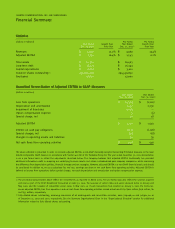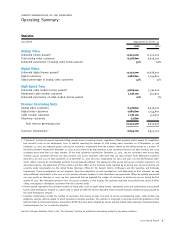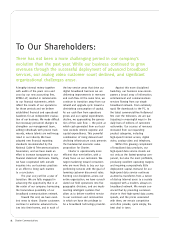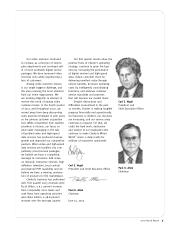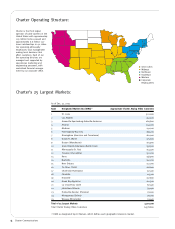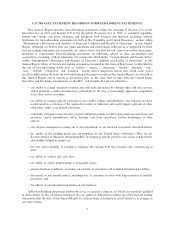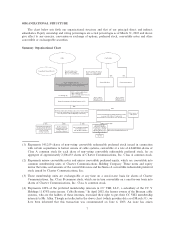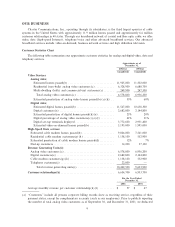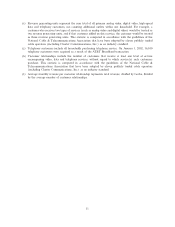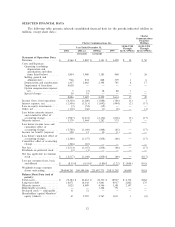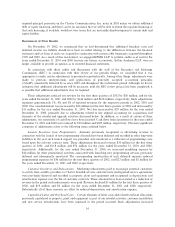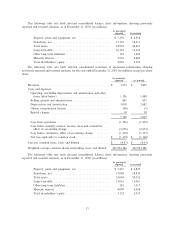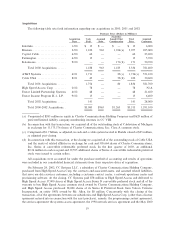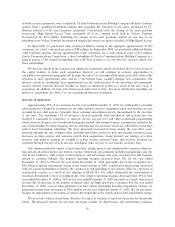Charter 2002 Annual Report Download - page 12
Download and view the complete annual report
Please find page 12 of the 2002 Charter annual report below. You can navigate through the pages in the report by either clicking on the pages listed below, or by using the keyword search tool below to find specific information within the annual report.46,000 and 45,000 customers, respectively, from the numbers shown on the billing records as a reserve.
Of the total customers reported for December 31, 2002, 93,000 customers were 60-90 days overdue, 5,000
customers were 90-120 days overdue, and 1,000 customers were more than 120 days overdue. Of the total
customers reported for December 31, 2001, 160,000 customers were 60-90 days overdue, 55,000
customers were 90-120 days overdue, and 31,000 customers were more than 120 days overdue. Such
delinquent customers represent 1.5% and 3.5% of total customers as of December 31, 2002 and 2001,
respectively. For 2002 and 2001, our year-end Ñnancial statements reÖect a reserve for uncollectible
accounts that we deemed suÇcient. The adequacy of the 46,000 and 45,000 customer reductions, our
disconnect policies, the application of those policies and their eÅect on the customer totals reported by us
during 2001 and prior periods are currently under investigation by the United States Attorney's OÇce for
the Eastern District of Missouri and the Securities and Exchange Commission. Those investigations are
not complete. Upon the completion of such investigations, and depending on their outcome, we may
make additional adjustments in the 2001 or prior periods customer numbers if such adjustments are
appropriate. When we publicly announced our 2001 results on February 11, 2002, we also announced that
we expected the number of customers to decline by 120,000 during the Ñrst quarter of 2002. We
ultimately reported a loss of 145,000 customers in that quarter. The customer reduction was primarily the
result of eliminating non-paying or delinquent customers from the customer totals.
(b) Homes passed represents the estimated number of living units, such as single family homes, apartment
units and condominium units passed by the cable distribution network in a given area to which we oÅer
the service indicated. Homes passed excludes commercial units passed by the cable distribution network.
(c) Analog video customers include all customers who purchase video services (including those who also
purchase data and telephony services), but excludes approximately 55,900 and 17,500 customer
relationships, respectively, who pay for cable modem service only and who are only counted as cable
modem customers. This represents a change in our methodology from prior reports through Septem-
ber 30, 2002, in which cable modem only customer relationships were included within our analog video
customers. We made this change because we determined that most of these customers were unable to
receive our most basic level of analog service because this service was physically secured or blocked, was
unavailable in certain areas or the customers were unaware that this service was available to them. Had
we previously utilized this new reporting methodology, analog video customers (excluding cable modem
only) would have been approximately 6,647,600 as of September 30, 2002. Commercial and multi-
dwelling structures are calculated on an equivalent bulk unit (""EBU'') basis. EBU is calculated for a
system by dividing the bulk price charged to accounts in an area by the most prevalent price charged to
non-bulk residential customers in that market for the comparable tier of service. The EBU method of
estimating analog video customers is consistent with the methodology used in determining costs paid to
programmers and has been consistently applied year over year. As we increase our eÅective analog prices
to residential customers without a corresponding increase in the prices charged to commercial service or
multi-dwelling customers, our EBU count will decline even if there is no real loss in commercial service
or multi-dwelling customers. Our policy is not to count complimentary accounts (such as our employees)
as customers.
(d) Penetration represents customers as a percentage of homes passed.
(e) Digital video customers include all households that have one or more digital set-top terminals. Included
in digital video customers at December 31, 2002 and 2001 are approximately 27,500 and approximately
34,800 customers, respectively, that receive digital video service directly through satellite transmission.
(f) Represents the number of digital video customers as a percentage of analog video customers.
(g) As noted above, all of these customers also receive video service and are included in the video statistics
above, except that the video statistics do not include approximately 55,900 and 17,500 customers at
December 31, 2002 and 2001, respectively, who were cable modem only customers.
(h) Commercial cable modem or data customers historically were calculated on an Equivalent Modem Unit
or EMU basis, which involves converting commercial revenues to residential customer counts. EMU's
calculated under the historical method were approximately 98,700 and approximately 54,800 as of
December 31, 2002 and 2001, respectively. Commercial EMUs are not included in the above table.
10


